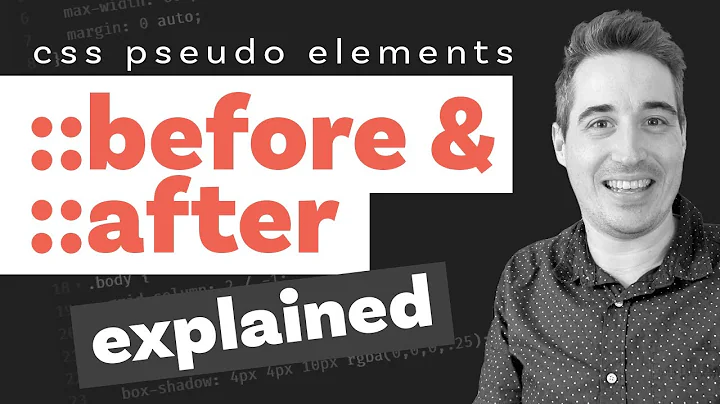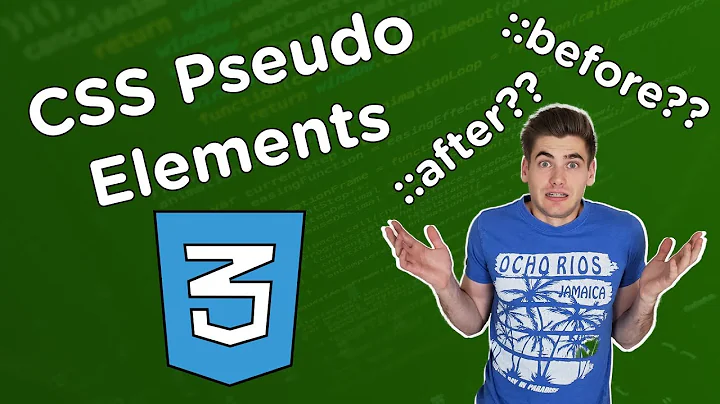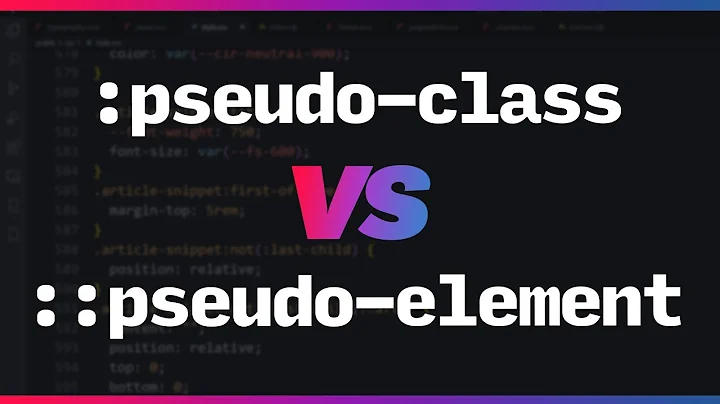What is the difference between a pseudo-class and a pseudo-element in CSS?
Solution 1
The CSS 3 selector recommendation is pretty clear about both, but I'll try to show the differences anyway.
Pseudo-classes
Official description
The pseudo-class concept is introduced to permit selection based on information that lies outside of the document tree or that cannot be expressed using the other simple selectors.
A pseudo-class always consists of a "colon" (
:) followed by the name of the pseudo-class and optionally by a value between parentheses.Pseudo-classes are allowed in all sequences of simple selectors contained in a selector. Pseudo-classes are allowed anywhere in sequences of simple selectors, after the leading type selector or universal selector (possibly omitted). Pseudo-class names are case-insensitive. Some pseudo-classes are mutually exclusive, while others can be applied simultaneously to the same element. Pseudo-classes may be dynamic, in the sense that an element may acquire or lose a pseudo-class while a user interacts with the document.
What does this mean?
The important nature of pseudo-classes is stated in the very first sentence: "the pseudo-class concept [...] permit selection". It enables the author of an stylesheet to differ between elements based on information that "lies outside of the document tree", for example the current status of a link (:active,:visited). Those aren't saved anywhere in the DOM, and there exists no DOM interface to access these options.
On the other hand, :target could be accessed via DOM manipulation (you could use window.location.hash in order to find the object with JavaScript), but this "cannot be expressed using the other simple selectors".
So basically a pseudo-class will refine the set of selected elements as any other simple selector in a sequence of simple selectors. Note that all simple selectors in a sequence of simple selectors will be evaluated at the same time. For a complete list of pseudo-class check the CSS3 selector recommendation.
Example
The following example will color all even rows gray (#ccc), all uneven rows which aren't dividable by 5 white and every other row magenta.
table tr:nth-child(2n) td{
background-color: #ccc;
}
table tr:nth-child(2n+1) td{
background-color: #fff;
}
table tr:nth-child(2n+1):nth-child(5n) td{
background-color: #f0f;
}
Pseudo-elements
Official description
Pseudo-elements create abstractions about the document tree beyond those specified by the document language. For instance, document languages do not offer mechanisms to access the first letter or first line of an element's content. Pseudo-elements allow authors to refer to this otherwise inaccessible information. Pseudo-elements may also provide authors a way to refer to content that does not exist in the source document (e.g., the
::beforeand::afterpseudo-elements give access to generated content).A pseudo-element is made of two colons (
::) followed by the name of the pseudo-element.This
::notation is introduced by the current document in order to establish a discrimination between pseudo-classes and pseudo-elements. For compatibility with existing style sheets, user agents must also accept the previous one-colon notation for pseudo-elements introduced in CSS levels 1 and 2 (namely, :first-line, :first-letter, :before and :after). This compatibility is not allowed for the new pseudo-elements introduced in this specification.Only one pseudo-element may appear per selector, and if present it must appear after the sequence of simple selectors that represents the subjects of the selector.
Note: A future version of this specification may allow multiple pseudo-elements per selector.
What does this mean?
The most important part here is that "pseudo-elements allow authors to refer to [..] otherwise inaccessible information" and that they "may also provide authors a way to refer to content that does not exist in the source document (e.g., the ::before and ::after pseudo-elements give access to generated content).". The biggest difference is that they actually create a new virtual element on which rules and even pseudo-class selectors can be applied to. They don't filter elements, they basically filter content (::first-line,::first-letter) and wrap it in a virtual container, which the author can style however he want (well, almost).
For example the ::first-line pseudo-element cannot be reconstructed with JavaScript, as it heavily depends on the current used font, the fonts size, the elements width, floating elements (and probably the time of the day). Well, that's not entirely true: one could still calculate all those values and extract the first line, however doing so is a very cumbersome activity.
I guess the biggest difference is that "only one pseudo-element may appear per selector". The note says that this could be subject to change, but as of 2012 I don't believe we see any different behavior in the future (it's still in CSS4).
Example
The following example will add a language-tag to every quote on a given page using the pseudo-class :lang and the pseudo-element ::after:
q:lang(de)::after{
content: " (German) ";
}
q:lang(en)::after{
content: " (English) ";
}
q:lang(fr)::after{
content: " (French) ";
}
q:not(:lang(fr)):not(:lang(de)):not(:lang(en))::after{
content: " (Unrecognized language) ";
}
TL;DR
Pseudo-classes act as simple selectors in a sequence of selectors and thereby classify elements on non-presentational characteristics, pseudo-elements create new virtual elements.
References
W3C
- Selectors Level 3
-
CSS 2.1 Specification (outdated but still informative)
-
5.2 Selector syntax:
A simple selector is either a type selector or universal selector followed immediately by zero or more attribute selectors, ID selectors, or pseudo-classes, in any order. The simple selector matches if all of its components match.
- 5.10 Pseudo-elements and pseudo-classes
-
5.2 Selector syntax:
Solution 2
A pseudo-class filters existing elements.
a:link means all <a>s that are :link.
A pseudo-element is a new fake element.
div::after means non-existing elements after <div>s.
::selection is another example of a pseudo-element.
It doesn't mean all elements that are selected; it means the range of content that is selected, which may span portions of multiple elements.
Solution 3
Short description that helped me to understand the difference:
- Pseudo-classes describe a special state.
- Pseudo-elements match virtual elements.
Solution 4
Below is the simple answer:
We use pseudo-class when we need to apply css based on the state of an element. Such as:
- Apply css on hover of anchor element (
:hover) - Apply css when gets focus on an html element (
:focus). etc.
We use pseudo-element when we need to apply css to the specific parts of an elements or a newly inserted content. Such as:
- Apply the css to first letter or first line of an element (
::first-letter) - Insert content before, or after, the content of an element (
::before,::after)
Below is the example of both:
<html>
<head>
<style>
p::first-letter { /* pseudo-element */
color: #ff0000;
}
a:hover { /* pseudo-class */
color: red;
}
</style>
</head>
<body>
<a href="#" >This is a link</a>
<p>This is a paragraph.</p>
</body>
</html>
Solution 5
From the Sitepoint docs:
A pseudo-class is similar to a class in HTML, but it’s not specified explicitly in the markup. Some pseudo-classes are dynamic—they’re applied as a result of user interaction with the document. - http://reference.sitepoint.com/css/pseudoclasses. These would be things like
:hover, :active, :visited.Pseudo-elements match virtual elements that don’t exist explicitly in the document tree. Pseudo-elements can be dynamic, inasmuch as the virtual elements they represent can change, for example, when the width of the browser window is altered. They can also represent content that’s generated by CSS rules. - http://reference.sitepoint.com/css/pseudoelements. These would be things like
::before, ::after, ::first-letter.
Related videos on Youtube
tybro0103
Coffee junkie, computer nerd, fitness monster, and father of two cool dudes.
Updated on January 21, 2021Comments
-
 tybro0103 over 3 years
tybro0103 over 3 yearsThings like
a:linkordiv::after...Information on the difference seems scarce.
-
 tybro0103 over 12 years@ŠimeVidas to what post? link?
tybro0103 over 12 years@ŠimeVidas to what post? link? -
zzzzBov over 12 yearsI think the spec is pretty clear...
-
Šime Vidas over 12 years@tybro0103 I didn't find any. I guess this indeed has never been asked here... I found this though: stackoverflow.com/questions/7757943/what-is-a-pseudo-element
-
 tybro0103 over 12 years@zzzzBov I feel like I need a translator to understand that :)
tybro0103 over 12 years@zzzzBov I feel like I need a translator to understand that :) -
BoltClock over 12 yearsThank you for posting this question. I'm not sure why I hadn't thought of posting it myself after my recent blitzkrieg on questions with the [pseudo-selector] tag...
-
starbeamrainbowlabs over 11 years@zzzzBov The problem with the spec is that it is rather wordy, long, and complex. Somebody needs to make a reference page or something. That would definitely help.
-
-
BoltClock over 12 years+1 although technically
div::afteris a child ofdiv, occurring after its contents rather than the element itself. -
DanMan about 12 yearsInstead of "filters" I'd say "further describes".
-
BoltClock almost 12 yearsI agree with DanMan's comment on SLaks' answer in that pseudo-classes don't really act as "filters" but more as "descriptors". For example,
:not(.someclass):nth-child(even)doesn't mean to filter out elements that don't have.someclass, and among the remaining elements filter out the even occurrences. Instead it represents any element that is both:not(.someclass)and:nth-child(even)of its parent at the same time. More in-depth explanations can be found in this answer and this answer. -
Zeta almost 12 years@BoltClock: I believe I like the term "characteristic-classifier" most, since that's what they were somewhat originally described as in CSS2: "Pseudo-classes classify elements on characteristics other than their name". However, I still haven't found the exact wording I'm happy with.
-
ashok_khuman over 3 yearspseudo-element is a "new fake element". it can't be a new fake element every time, example p::first-letter targets the existing(not new fake one) first letter.





